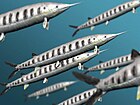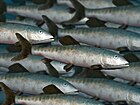Bonnerichthys
| Bonnerichthys Temporal range: Late Cretaceous,
| |
|---|---|

| |
| Restoration | |
| Scientific classification | |
| Domain: | Eukaryota |
| Kingdom: | Animalia |
| Phylum: | Chordata |
| Class: | Actinopterygii |
| Order: | †Pachycormiformes |
| Family: | †Pachycormidae |
| Genus: | †Bonnerichthys Friedman et al., 2010 |
| Species: | †B. gladius
|
| Binomial name | |
| †Bonnerichthys gladius (Cope, 1873)
| |
| Synonyms | |
| |
Bonnerichthys is a genus of fossil fishes within the family Pachycormidae that lived during the Late Cretaceous Period [1] Fossil remains of this taxon were first described from the Smoky Hill Member of the Niobrara Chalk Formation of Kansas (Late Coniacian-Early Campanian, about 87-81 million years ago), and additional material was later reported from the Pierre Shale, Mooreville Chalk, Demopolis Chalk, Wenonah Formation, and Moreno Formation, among other localities.[2] It grew to around 6 m (20 ft) in length, substantially less than the related Leedsichthys from the Jurassic which likely grew up to 17 m (56 ft).[3]
Feeding
One of the most significant features of Bonnerichthys is the recognition that it was a filter feeder, living on plankton. This recognition that many large-bodied fish from the Mesozoic in the Pachycormidae were filter feeders shows that this niche was filled for at least 100 million years before previously known. The modern niche is filled by several species of sharks and the baleen whales.
The international team that described the genus named it after the Marion Charles Bonner fossil hunting family,[4] whose collections from the Niobrara Cretaceous chalk of western Kansas are in many museums and research institutions.
References
- ^ FRIEDMAN, M., K. SHIMADA, L. MARTIN, M. J. EVERHART, J. LISTON, A. MALTESE, AND M. TRIEBOLD. 2010. 100-million-year dynasty of giant planktivorous bony fishes in the Mesozoic seas. Science, 327:990-993.
- ^ Friedman, Matt; Shimada, Kenshu; Everhart, Michael J.; Irwin, Kelly J.; Grandstaff, Barbara S.; Stewart, J. D. (8 January 2013). "Geographic and stratigraphic distribution of the Late Cretaceous suspension-feeding bony fish Bonnerichthys gladius (Teleostei, Pachycormiformes)". Journal of Vertebrate Paleontology. 33 (1): 35–47. doi:10.1080/02724634.2012.713059. S2CID 128958842.
- ^ Viegas, Jennifer (18 February 2010), SUV-Sized Fish Were Earliest Filter-Feeders, Discovery News, retrieved 1 April 2010
- ^ "The Big Fish that Ate Small". 15 May 2014.
External links
- Bonnerichthys at the Oceans of Kansas website. Includes detailed taxonomic history, life restorations, bibliography, many photos of fossil remains.
- Bonnerichthys discussion at boneblogger.com







